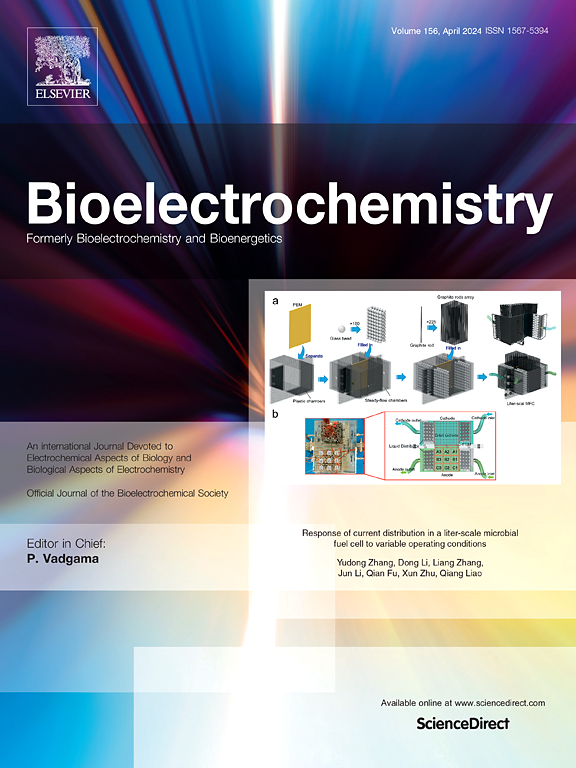基于金纳米颗粒和碳纳米管网络的无创酒精生物传感器动态监测汗液酒精
IF 4.8
2区 化学
Q1 BIOCHEMISTRY & MOLECULAR BIOLOGY
引用次数: 0
摘要
酗酒会导致健康问题或对社会造成其他潜在危害。因此,准确检测人体体液中的酒精浓度是一项重要而具有挑战性的任务。本文报道了一种高效、可靠、高灵敏度、高选择性监测汗液中酒精含量的方法。这种可拉伸的酒精生物传感器是通过将多壁碳纳米管(MWCNTs)薄膜转移到聚二甲基硅氧烷(PDMS)底物上,然后固定化金纳米颗粒(AuNPs)和酒精氧化酶(AOx)制成的。该生物传感器具有令人满意的机械稳定性,包括优异的抗拉伸、弯曲和扭转性能。MWCNTs和AuNPs在电极表面形成的三明治结构为生物传感器提供了优异的导电性和电化学性能。该传感器对乙醇的线性范围为1.5 μM ~ 30 mM,检出限为0.5 μM。此外,由于AOx的特异性,该生物传感器显示出良好的选择性。实际样品测试表明,所构建的生物传感器具有监测汗液酒精的能力,其结果与气相色谱法的结果一致。该研究为柔性电化学生物传感器的开发提供了一种多用途的方法,在无创准确检测人体汗液中的酒精方面具有广阔的应用前景。本文章由计算机程序翻译,如有差异,请以英文原文为准。

Non-invasive alcohol biosensor based on gold nanoparticles and carbon nanotubes network for dynamic monitoring of sweat alcohol
Intemperance can lead to health issues or other potential harms to society. Consequently, accurate detection of alcohol concentration in human fluid is an essential and challenging task. In this paper, we reported an efficient and reliable method for highly sensitive and selective monitoring of alcohol in sweat. This stretchable alcohol biosensor has been fabricated by transferring multi-walled carbon nanotubes (MWCNTs) film on polydimethylsiloxane (PDMS) substrate followed by immobilization of Au nanoparticles (AuNPs) and alcohol oxidase enzyme (AOx). The biosensor possesses satisfactory mechanical stability, including excellent resistance to stretching, bending and twisting. Sandwich structure formed on the electrode surface by MWCNTs and AuNPs provides excellent electrical conductivity and electrochemical performance for biosensors. The biosensor exhibited a wide linear range from 1.5 μM to 30 mM toward alcohol and the detection limit was 0.5 μM. Furthermore, owing to the specificity of the AOx, the biosensor displayed splendid selectivity. The real sample tests show that the constructed biosensor has the ability to monitor sweat alcohol, and the results were consistent with those obtained by gas chromatography. This research offers a versatile method for the development of flexible electrochemical biosensors, which has promising applications in noninvasive and accurate detection of alcohol in human sweat.
求助全文
通过发布文献求助,成功后即可免费获取论文全文。
去求助
来源期刊

Bioelectrochemistry
生物-电化学
CiteScore
9.10
自引率
6.00%
发文量
238
审稿时长
38 days
期刊介绍:
An International Journal Devoted to Electrochemical Aspects of Biology and Biological Aspects of Electrochemistry
Bioelectrochemistry is an international journal devoted to electrochemical principles in biology and biological aspects of electrochemistry. It publishes experimental and theoretical papers dealing with the electrochemical aspects of:
• Electrified interfaces (electric double layers, adsorption, electron transfer, protein electrochemistry, basic principles of biosensors, biosensor interfaces and bio-nanosensor design and construction.
• Electric and magnetic field effects (field-dependent processes, field interactions with molecules, intramolecular field effects, sensory systems for electric and magnetic fields, molecular and cellular mechanisms)
• Bioenergetics and signal transduction (energy conversion, photosynthetic and visual membranes)
• Biomembranes and model membranes (thermodynamics and mechanics, membrane transport, electroporation, fusion and insertion)
• Electrochemical applications in medicine and biotechnology (drug delivery and gene transfer to cells and tissues, iontophoresis, skin electroporation, injury and repair).
• Organization and use of arrays in-vitro and in-vivo, including as part of feedback control.
• Electrochemical interrogation of biofilms as generated by microorganisms and tissue reaction associated with medical implants.
 求助内容:
求助内容: 应助结果提醒方式:
应助结果提醒方式:


